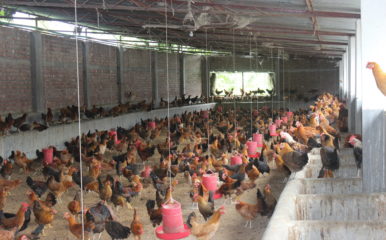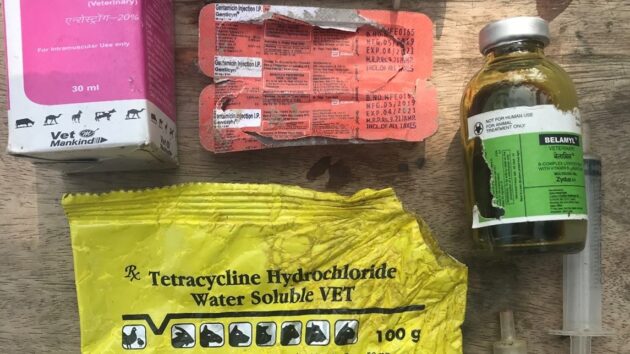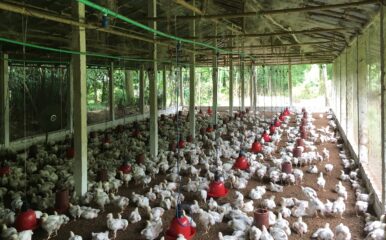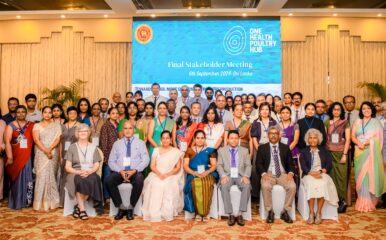
Uncertainty, antibiotic use in contract chicken farming and a way forward
Published on 14/01/2025

Mat Hennessey
People are consuming more and more chicken. So much, in fact, that chicken production recently became the biggest terrestrial livestock sector by weight produced. Over 100 million tons are now produced globally each year.
Chickens can now be ready for slaughter in as few as 35 days. Together with the fact that chickens need much less feed to produce a kilogram of meat than larger livestock, this makes poultry production both an efficient way of producing meat – and one way of satisfying the growing global meat demand.
Antimicrobial resistance
However, there are concerns about high levels of antibiotics being used to support chickens produced in this way. Large numbers of chickens are often housed together in a relatively small space and, in these conditions, if infectious diseases are introduced they can spread quickly. Consequently, antibiotics are commonly used to treat and protect birds against disease. In some situations, they are also used to grow birds quicker.
Using antibiotics can lead to bacteria becoming resistant to them – which then threatens our ability to treat infections in both animals and people. Over half the world’s antibiotics are used in livestock production and the growth of antimicrobial resistance (AMR) is a major global health concern.
While most of the world’s chickens are produced by the USA, China and Brazil, chicken production is increasing rapidly in many South Asian countries, including India. To investigate how chickens are being produced here I travelled to Kolkata, the capital of West Bengal, India. During this fieldwork trip we visited people working in the poultry industry, including farmers, veterinarians and people working with poultry companies. Our aim was to understand the types of decisions being made which lead to antibiotics being used – and hence may be contributing to the spread of AMR.
Contract farming
Our study, undertaken in collaboration with West Bengal University of Animal & Fishery Science, indicated that most chicken production around Kolkata is under corporate contract farming arrangements in which poultry companies supply farmers with all they need to produce chickens for meat.
This arrangement suits the poultry companies, who don’t have to invest in land and sheds to undertake production themselves. It suits some farmers too, who no longer need to buy what are known as the ‘inputs’ for poultry production themselves (chicks, feed and medicines).
When the chickens the farmers ‘grow’’ are large enough to be eaten (usually around 2.5kg), the companies send in their delivery lorries to collect the birds, which are transported to markets where consumers most often purchase them live, to be slaughtered there and then. The farmers get paid a fee for each chicken produced.

In West Bengal, most farmers we spoke to had chicken sheds housing 1,000 to 2,000 birds (small compared to the large industrial farms in the UK, China, and Brazil). The sheds are often open-sided, constructed from brick, timber and wire mesh, and have earth floors. These ‘open housing’ systems make biosecurity a challenge for production as chickens can be exposed to circulating infectious diseases. Furthermore, while birds are partially protected, they remain exposed to the extremes of heat and humidity.
Antibiotic use decisions
Our research indicated that under contract farming, the decision to use antibiotics or not is taken by executives (managers and veterinarians) working for contact companies. They base these decisions on several factors including the standard of infrastructure (housing and water supply) on the farm, the weather and previous experience of production on a particular farm. Instructions on whether to use antibiotics are communicated to farmers through supervisors who visit farmers every one to two days.
Contracting farmers, therefore, rarely make decisions on antibiotic use themselves.
Companies, vets and farmers told us antibiotics were routinely used – including macrolide and fluoroquinolone antibiotics which the World Health Organization (WHO) deems critically important for human health. Critically important antibiotics should be reserved to treat serious bacterial infections in people and never routinely used in livestock production.
Production uncertainty
Many of the people we spoke to, including vets and people working for poultry companies, expressed concern about birds being exposed to Mycoplasma from chicks arriving from breeding farms. Mycoplasma is a bacteria which can cause respiratory illness in chickens and so antibiotics were used to compensate for this uncertainty.
Other people, including many farmers, were concerned about local water sources being contaminated with E. coli, a bacteria which can cause respiratory disease and peritonitis in chickens and gastrointestinal disease in people. As a result, again, antibiotics were commonly given.
Further research is needed to investigate these two causes of uncertainty currently contributing to antibiotic usage. Many of the people we talked to expressed concern about the use of antibiotics in chicken production. Several detailed how companies were starting to use antibiotic alternatives, including probiotics and compounds which can be added to water to improve chicken’s disease defences. However, alternatives were reported to be more expensive and less effective.
Influence and antibiotic stewardship
It is now estimated that 80% of India’s chicken production occurs under contract arrangements. Given this dominance, we argue poultry companies have considerable influence, which may be advantageous for antibiotic stewardship if they can work together and with government. We suggest an advantage of corporate farming could be that companies are well positioned to coordinate a transition to low antibiotic use systems.
To move towards systems which rely less on antibiotics, contract companies need to find ways of supporting farmers and improving biosecurity. This could, for example, include developing model farms to demonstrate different housing systems, and providing credit schemes to allow farmers to invest in infrastructure upgrading.
Corporate social responsibility
One step might be for India to make antibiotic reform an explicit focus of corporate social responsibility (CSR). In 2013, India made CSR a legal requirement and companies must now invest a percentage of their profits to social causes. By focusing on antibiotic resistance as a negative side effect of the poultry sector, CSR could encourage poultry companies in invest in the many changes needed to reduce antibiotic use.
By focusing the responsibility of antibiotic use on corporations rather than on the actions of farmers, which some antibiotic campaigns have, stewardship interventions can consider the decisions which occur in the whole chicken production system. This type of systems approach needs to include all stakeholders, including in other areas of the food system.
Importantly, chicken farming remains an important source of income to many smallholder farmers in West Bengal, and indeed across much of India. Any attempts by companies and the state to change the way antibiotics are used will need to consider the effect on farmers’ livelihoods. Such change cannot be achieved overnight and a longer-term vision moving towards more sustainable low antibiotic use systems will be needed.


